+ Open data
Open data
- Basic information
Basic information
| Entry | Database: PDB / ID: 6xt9 | ||||||
|---|---|---|---|---|---|---|---|
| Title | Subunits BBS 1,4,8,9,18 of the human BBSome complex | ||||||
 Components Components |
| ||||||
 Keywords Keywords | PROTEIN TRANSPORT / ciliary transport / Arl6 effector / adaptor protein / complex | ||||||
| Function / homology |  Function and homology information Function and homology informationregulation of non-motile cilium assembly / protein localization to photoreceptor outer segment / receptor localization to non-motile cilium / BBSome / photoreceptor cell morphogenesis / retinal rod cell development / sperm flagellum assembly / negative regulation of appetite by leptin-mediated signaling pathway / photoreceptor cell outer segment organization / smoothened binding ...regulation of non-motile cilium assembly / protein localization to photoreceptor outer segment / receptor localization to non-motile cilium / BBSome / photoreceptor cell morphogenesis / retinal rod cell development / sperm flagellum assembly / negative regulation of appetite by leptin-mediated signaling pathway / photoreceptor cell outer segment organization / smoothened binding / olfactory behavior / regulation of cilium beat frequency involved in ciliary motility / microtubule anchoring at centrosome / protein localization to organelle / sensory processing / ciliary transition zone / photoreceptor connecting cilium / patched binding / negative regulation of actin filament polymerization / BBSome-mediated cargo-targeting to cilium / ventricular system development / positive regulation of cilium assembly / striatum development / melanosome transport / sensory perception / protein localization to cilium / maintenance of protein location in nucleus / positive regulation of multicellular organism growth / photoreceptor cell maintenance / Golgi to plasma membrane protein transport / regulation of stress fiber assembly / non-motile cilium assembly / brain morphogenesis / negative regulation of systemic arterial blood pressure / retina homeostasis / fertilization / hormone metabolic process / non-motile cilium / cartilage development / protein localization to centrosome / centrosome cycle / neural precursor cell proliferation / fat pad development / eating behavior / motile cilium / ciliary membrane / erythrocyte homeostasis / heart looping / fat cell differentiation / face development / pericentriolar material / adult behavior / dendrite development / B cell homeostasis / dynactin binding / mitotic cytokinesis / regulation of lipid metabolic process / cilium assembly / social behavior / axoneme / spermatid development / anatomical structure morphogenesis / photoreceptor outer segment / intracellular transport / alpha-tubulin binding / beta-tubulin binding / photoreceptor inner segment / visual perception / centriole / response to endoplasmic reticulum stress / regulation of cytokinesis / hippocampus development / neural tube closure / phosphoprotein binding / cerebral cortex development / lipid metabolic process / microtubule cytoskeleton organization / centriolar satellite / fibrillar center / neuron migration / Wnt signaling pathway / sensory perception of smell / protein transport / retina development in camera-type eye / protein-macromolecule adaptor activity / gene expression / RNA polymerase II-specific DNA-binding transcription factor binding / cilium / ciliary basal body / negative regulation of gene expression / centrosome / nucleoplasm / nucleus / membrane / cytosol / cytoplasm Similarity search - Function | ||||||
| Biological species |  Homo sapiens (human) Homo sapiens (human) | ||||||
| Method | ELECTRON MICROSCOPY / single particle reconstruction / cryo EM / Resolution: 3.8 Å | ||||||
 Authors Authors | Klink, B.U. / Raunser, S. / Gatsogiannis, C. | ||||||
| Funding support |  Germany, 1items Germany, 1items
| ||||||
 Citation Citation |  Journal: Elife / Year: 2020 Journal: Elife / Year: 2020Title: Structure of the human BBSome core complex. Authors: Björn Udo Klink / Christos Gatsogiannis / Oliver Hofnagel / Alfred Wittinghofer / Stefan Raunser /  Abstract: The BBSome is a heterooctameric protein complex that plays a central role in primary cilia homeostasis. Its malfunction causes the severe ciliopathy Bardet-Biedl syndrome (BBS). The complex acts as a ...The BBSome is a heterooctameric protein complex that plays a central role in primary cilia homeostasis. Its malfunction causes the severe ciliopathy Bardet-Biedl syndrome (BBS). The complex acts as a cargo adapter that recognizes signaling proteins such as GPCRs and links them to the intraflagellar transport machinery. The underlying mechanism is poorly understood. Here we present a high-resolution cryo-EM structure of a human heterohexameric core subcomplex of the BBSome. The structure reveals the architecture of the complex in atomic detail. It explains how the subunits interact with each other and how disease-causing mutations hamper this interaction. The complex adopts a conformation that is open for binding to membrane-associated GTPase Arl6 and a large positively charged patch likely strengthens the interaction with the membrane. A prominent negatively charged cleft at the center of the complex is likely involved in binding of positively charged signaling sequences of cargo proteins. | ||||||
| History |
|
- Structure visualization
Structure visualization
| Movie |
 Movie viewer Movie viewer |
|---|---|
| Structure viewer | Molecule:  Molmil Molmil Jmol/JSmol Jmol/JSmol |
- Downloads & links
Downloads & links
- Download
Download
| PDBx/mmCIF format |  6xt9.cif.gz 6xt9.cif.gz | 395.7 KB | Display |  PDBx/mmCIF format PDBx/mmCIF format |
|---|---|---|---|---|
| PDB format |  pdb6xt9.ent.gz pdb6xt9.ent.gz | 309.9 KB | Display |  PDB format PDB format |
| PDBx/mmJSON format |  6xt9.json.gz 6xt9.json.gz | Tree view |  PDBx/mmJSON format PDBx/mmJSON format | |
| Others |  Other downloads Other downloads |
-Validation report
| Summary document |  6xt9_validation.pdf.gz 6xt9_validation.pdf.gz | 994.7 KB | Display |  wwPDB validaton report wwPDB validaton report |
|---|---|---|---|---|
| Full document |  6xt9_full_validation.pdf.gz 6xt9_full_validation.pdf.gz | 1014 KB | Display | |
| Data in XML |  6xt9_validation.xml.gz 6xt9_validation.xml.gz | 65 KB | Display | |
| Data in CIF |  6xt9_validation.cif.gz 6xt9_validation.cif.gz | 97.1 KB | Display | |
| Arichive directory |  https://data.pdbj.org/pub/pdb/validation_reports/xt/6xt9 https://data.pdbj.org/pub/pdb/validation_reports/xt/6xt9 ftp://data.pdbj.org/pub/pdb/validation_reports/xt/6xt9 ftp://data.pdbj.org/pub/pdb/validation_reports/xt/6xt9 | HTTPS FTP |
-Related structure data
| Related structure data |  10617MC  6xtbC C: citing same article ( M: map data used to model this data |
|---|---|
| Similar structure data |
- Links
Links
- Assembly
Assembly
| Deposited unit | 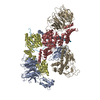
|
|---|---|
| 1 |
|
- Components
Components
| #1: Protein | Mass: 65159.266 Da / Num. of mol.: 1 Source method: isolated from a genetically manipulated source Source: (gene. exp.)  Homo sapiens (human) / Gene: BBS1, BBS2L2 / Cell line (production host): Hi5 / Production host: Homo sapiens (human) / Gene: BBS1, BBS2L2 / Cell line (production host): Hi5 / Production host:  Trichoplusia ni (cabbage looper) / References: UniProt: Q8NFJ9 Trichoplusia ni (cabbage looper) / References: UniProt: Q8NFJ9 |
|---|---|
| #2: Protein | Mass: 59463.020 Da / Num. of mol.: 1 Source method: isolated from a genetically manipulated source Source: (gene. exp.)  Homo sapiens (human) / Gene: BBS4 / Cell line (production host): Hi5 / Production host: Homo sapiens (human) / Gene: BBS4 / Cell line (production host): Hi5 / Production host:  Trichoplusia ni (cabbage looper) / References: UniProt: Q96RK4 Trichoplusia ni (cabbage looper) / References: UniProt: Q96RK4 |
| #3: Protein | Mass: 58702.539 Da / Num. of mol.: 1 Source method: isolated from a genetically manipulated source Source: (gene. exp.)  Homo sapiens (human) / Gene: TTC8 / Cell line (production host): Hi5 / Production host: Homo sapiens (human) / Gene: TTC8 / Cell line (production host): Hi5 / Production host:  Trichoplusia ni (cabbage looper) / References: UniProt: A0A0C4DGY3 Trichoplusia ni (cabbage looper) / References: UniProt: A0A0C4DGY3 |
| #4: Protein | Mass: 99383.914 Da / Num. of mol.: 1 Source method: isolated from a genetically manipulated source Source: (gene. exp.)  Homo sapiens (human) / Gene: BBS9, PTHB1 / Cell line (production host): Hi5 / Production host: Homo sapiens (human) / Gene: BBS9, PTHB1 / Cell line (production host): Hi5 / Production host:  Trichoplusia ni (cabbage looper) / References: UniProt: Q3SYG4 Trichoplusia ni (cabbage looper) / References: UniProt: Q3SYG4 |
| #5: Protein | Mass: 15430.824 Da / Num. of mol.: 1 Source method: isolated from a genetically manipulated source Source: (gene. exp.)  Homo sapiens (human) / Gene: BBIP1, BBIP10, NCRNA00081 / Cell line (production host): Hi5 / Production host: Homo sapiens (human) / Gene: BBIP1, BBIP10, NCRNA00081 / Cell line (production host): Hi5 / Production host:  Trichoplusia ni (cabbage looper) / References: UniProt: A8MTZ0 Trichoplusia ni (cabbage looper) / References: UniProt: A8MTZ0 |
-Experimental details
-Experiment
| Experiment | Method: ELECTRON MICROSCOPY |
|---|---|
| EM experiment | Aggregation state: PARTICLE / 3D reconstruction method: single particle reconstruction |
- Sample preparation
Sample preparation
| Component | Name: BBSome core complex / Type: COMPLEX Details: BBSome core complex containing BBS1,4, 8, 9 and 18. BBS5 was also present in the sample preparation, but was only visible in a subset of particles (see related entry) Entity ID: all / Source: RECOMBINANT | ||||||||||||||||
|---|---|---|---|---|---|---|---|---|---|---|---|---|---|---|---|---|---|
| Molecular weight | Experimental value: NO | ||||||||||||||||
| Source (natural) | Organism:  Homo sapiens (human) Homo sapiens (human) | ||||||||||||||||
| Source (recombinant) | Organism:  Trichoplusia ni (cabbage looper) / Strain: Hi5 / Plasmid: ACEMBL Trichoplusia ni (cabbage looper) / Strain: Hi5 / Plasmid: ACEMBL | ||||||||||||||||
| Buffer solution | pH: 7.5 | ||||||||||||||||
| Buffer component |
| ||||||||||||||||
| Specimen | Conc.: 0.08 mg/ml / Embedding applied: NO / Shadowing applied: NO / Staining applied: NO / Vitrification applied: YES Details: The sample was cross linked with 0.5% glutaraldehyde | ||||||||||||||||
| Specimen support | Grid material: GOLD / Grid mesh size: 300 divisions/in. / Grid type: UltrAuFoil | ||||||||||||||||
| Vitrification | Instrument: FEI VITROBOT MARK III / Cryogen name: ETHANE / Humidity: 100 % / Chamber temperature: 286 K Details: double blot with 2 minutes incubation after first sample application |
- Electron microscopy imaging
Electron microscopy imaging
| Experimental equipment |  Model: Titan Krios / Image courtesy: FEI Company |
|---|---|
| Microscopy | Model: FEI TITAN KRIOS |
| Electron gun | Electron source:  FIELD EMISSION GUN / Accelerating voltage: 300 kV / Illumination mode: OTHER FIELD EMISSION GUN / Accelerating voltage: 300 kV / Illumination mode: OTHER |
| Electron lens | Mode: BRIGHT FIELD / Calibrated defocus min: 300 nm / Calibrated defocus max: 1000 nm / Cs: 2.7 mm |
| Specimen holder | Cryogen: NITROGEN / Specimen holder model: FEI TITAN KRIOS AUTOGRID HOLDER |
| Image recording | Average exposure time: 15 sec. / Electron dose: 67 e/Å2 / Detector mode: COUNTING / Film or detector model: GATAN K2 SUMMIT (4k x 4k) / Num. of real images: 15266 |
| EM imaging optics | Energyfilter slit width: 20 eV / Phase plate: VOLTA PHASE PLATE |
| Image scans | Movie frames/image: 50 / Used frames/image: 1-50 |
- Processing
Processing
| EM software |
| |||||||||||||||||||||||||||||||||||||||||||||
|---|---|---|---|---|---|---|---|---|---|---|---|---|---|---|---|---|---|---|---|---|---|---|---|---|---|---|---|---|---|---|---|---|---|---|---|---|---|---|---|---|---|---|---|---|---|---|
| CTF correction | Type: PHASE FLIPPING AND AMPLITUDE CORRECTION | |||||||||||||||||||||||||||||||||||||||||||||
| Particle selection | Num. of particles selected: 2831329 | |||||||||||||||||||||||||||||||||||||||||||||
| Symmetry | Point symmetry: C1 (asymmetric) | |||||||||||||||||||||||||||||||||||||||||||||
| 3D reconstruction | Resolution: 3.8 Å / Resolution method: FSC 0.143 CUT-OFF / Num. of particles: 862114 / Symmetry type: POINT |
 Movie
Movie Controller
Controller





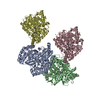
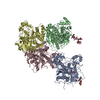
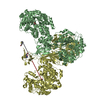
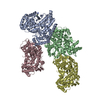
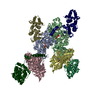
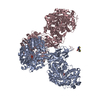
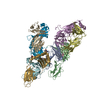
 PDBj
PDBj


